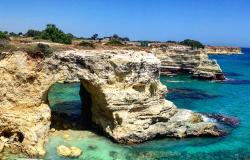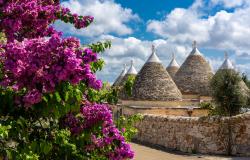Words and Pictures by Chris Poole
Occupying a strategically significant site in the Ionian Sea, and some 100 km to the south-east of the port of Taranto, Italy’s Gallipoli was important in Greek and Roman times, although it almost certainly dates further back in history.
Once an island fortress, an arched stone bridge was built in 1603 to connect the old town to the mainland. The bridge and part of the fortress remain today, as do the charm and character of the old town.
Thus, Gallipoli has two distinct parts and while the ‘new’ town with its grid structure of streets, boulevards, shops, homes and offices may have little of distinction to offer to visitors, the old town is well worth a visit for those who seek something off the beaten tourist track.
At the approach to the bridge leading from the ‘new’ town stands an ornate fountain called the ‘Greek’ fountain. From this pretty feature, the seven-arched bridge reaches across to the fortress standing sentinel at the entrance to the original town of Gallipoli.
The castle is closed to the public (for reasons which are unclear). It was built in the 17th century but stands on the site of earlier constructions. Between the castle and the bridge is a solid outer structure in the form of a ravelin (a wedge-shaped defensive structure).
These fortifications were built not only to protect the town but also its fishing port, which lies on the left as you cross the bridge into the old town.
Maritime Traditions
 Today fishing remains a major economic activity of Gallipoli, which has fleets of traditional blue fishing boats sheltering under the castle walls. The fishing port has its own church, Santa Maria del Caneto, now standing in the midst of small repair facilities, fishing boats and modern processing plants.
Today fishing remains a major economic activity of Gallipoli, which has fleets of traditional blue fishing boats sheltering under the castle walls. The fishing port has its own church, Santa Maria del Caneto, now standing in the midst of small repair facilities, fishing boats and modern processing plants.
To the north of the bridge there is a commercial port. Once an important facility for the olive oil trade, the port was completely rebuilt between the middle of the 18th and 19th centuries. It is now used by some commercial shipping but mostly by the Italian authorities such as the coastguard.
By the end of the 19th century, the town had been connected to Italy’s railway network and the castle walls had been removed to form a waterfront ring road around the old town, constructed on top of the lower walls.
All along this ‘riviera’, which circles the old town, elegant town houses rise, punctuated by churches – sometimes side-by-side. There are good restaurants, too, on this route around the old town.
It is not difficult to penetrate the city. Narrow streets and alleys run into the centre, with an almost canyon-like quality in places. The streets converge and meet in shady, tranquil courtyards and squares. Unlike more famous coastal towns around the Med, in Gallipoli you sense that here is a place where people really live and work. The old town is mostly residential with some small public administration offices and shops.
Unlike more famous coastal towns around the Med, in Gallipoli you sense that here is a place where people really live and work. The old town is mostly residential with some small public administration offices and shops.
Fruit and veg arrive in noisy three-wheeled trucks. These park in key places and the streets echo with the call of the traders announcing their presence. The streets also buzz with motor scooters, often with small children wedged between parents sitting fore and aft.
In the early afternoon siesta sets in. The narrow streets fall silent, waiting for the resumption of activity that comes with the cool of the evening.
A Feast of Decoration
 One thing you cannot escape from in Gallipoli is churches. They are everywhere. Many are in the ornate baroque style typical of the region. And many face the sea as if to look out for and welcome returning fishermen.
One thing you cannot escape from in Gallipoli is churches. They are everywhere. Many are in the ornate baroque style typical of the region. And many face the sea as if to look out for and welcome returning fishermen.
The church and former convent of St Francis of Assisi, at the town’s most westerly point, is a good example. It dates back to 1216, according to records, although almost nothing of that period remains. The present façade was completed in 1736 in local stone characteristic of the Salentine peninsular.
Nearby, two other churches sit side-by-side commanding a view to the south and west towards the low, flat island of St Andrea with its pure white lighthouse. Roughly in the centre of the old town is the cathedral.
Started in the first half of the 17th century, it has the ornate, baroque style so familiar in the Puglia region. It was here that another feature which was to become popular in other Salentine churches originated - highly decorated interiors using painted canvasses hung on the walls.
Within a few metres of the cathedral there is a wonderful pharmacy, complete with shelves of old ceramic jars and bottles and a lovely painted and vaulted timber ceiling.
To my mind, Gallipoli is a very real town representing, perhaps, the best of ‘old Europe’, albeit old southern Europe.
How to get to Gallipoli
The official tourism website www.pugliaturismo.com has some useful information.
British Airways (www.britishairways.com) has routes from Gatwick to Bari.
Ryanair (www.ryanair.com) operates from Stanstedto Bari and Brindisi.



